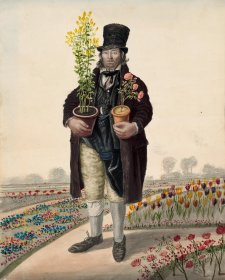Tommy Raeburn (1770–1843) lived near Kilmarnock, in the west of Scotland, his small fame deriving largely from his spectacular appearance.
The younger son of a local landowner, Tommy’s portion of the paternal inheritance was ‘Holmhead’ or ‘The Ark’, a cottage and 10 acres in the valley of the Irvine. This property was surrounded by other holdings, with the only road access through a neighbour’s farm. Unfortunately, the two fought, and, in pique, the neighbour closed the right of way. Raeburn took the matter to court, but lost the case. Disappointed and angry, he swore never to shave, cut his hair or change his coat until he received what he believed was justice. That judgement never came so, over time, his beard extended down his chest and his hair grew to a waist-length, matted dreadlock worn over his left shoulder, while the old coat slowly transformed into a fantastic, ragged patchwork. As his appearance grew stranger, his notoriety increased. Although nicknamed ‘The Ayrshire hermit’, he was certainly not a recluse, and a walk to Holmhead became something of a popular outing for the people of Kilmarnock, and an attraction for visitors.
Raeburn would entertain tourists with lemonade and ginger beer (and, occasionally, with illegal homemade whisky) and would show off his birdtaming skills as the robins from his garden perched on his beard to peck crumbs from between his lips. Although he kept a small dairy herd and made good cheese as well as the whisky, a substantial part of his income came from such tourism — an obituarist described his beard as ‘his almost entire stock in trade (and) the chief source of his revenue’. He was sufficiently famous to have his portrait appear both on the cover of a locally produced pamphlet and in the Illustrated London News, and for Dempsey to have repeated the Docker collection miniature as a silhouette.
Even in the 19th century, there was money in celebrity. Admittedly something of a miser, Raeburn left an estate of £2,400 (over £100,000 in today’s values) when he died, aged 73.
Collection: Tasmanian Museum and Art Gallery, presented by C. Docker, 1956



Dempsey’s people: a folio of British street portraits 1824–1844 is the first exhibition to showcase the compelling watercolour images of English street people made by the itinerant English painter John Dempsey throughout the first half of the nineteenth century.



Visit us, learn with us, support us or work with us! Here’s a range of information about planning your visit, our history and more!



We depend on your support to keep creating our programs, exhibitions, publications and building the amazing portrait collection!